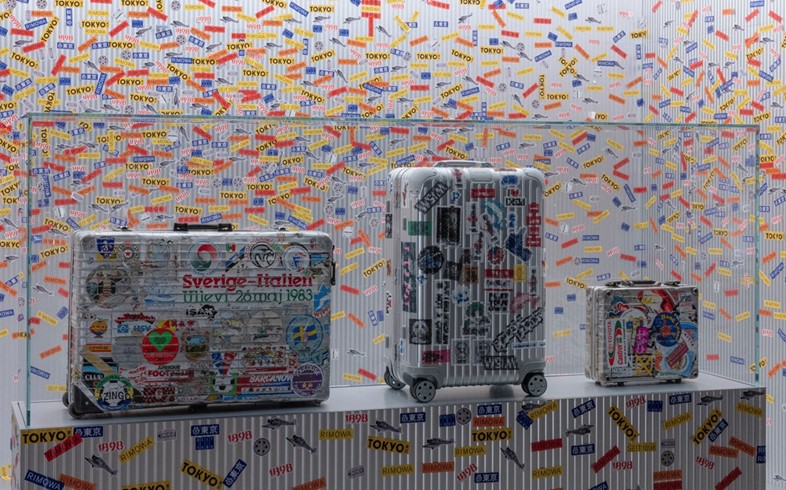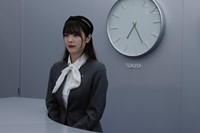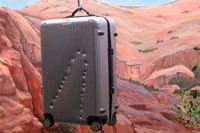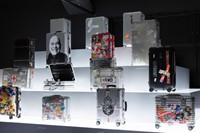In Tokyo, a nine-day exhibition charted the history of Rimowa, from its first trunks designed for steam-train and ship travel, to today as a luggage behemoth
This article is taken from the Autumn/Winter 2023 issue of AnOther Magazine:
With the luxury luggage brand Rimowa, the story is: there is no story. There’s simply a beautiful, functional product.
OK, there’s one fable, but even that remains unconfirmed. In the early 1930s, Görtz & Morszeck (as Rimowa was then called) was entering its fourth decade when the company’s factory in Cologne suffered a fire that devoured all its mate- rials bar one: a light grey, fire-resistant aluminium. When Paul Morszeck’s son Richard took over the business in 1937, he renamed it after himself, Richard Morszeck Warenzeichen (trademark), and launched the label’s first aluminium suitcase. This one did not possess the now-distinct industrial-looking grooves, but it was the start of the iconography we know today. And if the story is to be believed, it reveals the bedrock of the brand: absolute practicality. Aluminium had proved itself an indestructible material, plus there was a relative surplus.
In June this year, the gallery space Jing Harajuku – a shiny black box of a building at the intersection of Tokyo’s buzzy Harajuku, the tourist-filled Meiji Shrine and the leafy upscale shopping destination Omotesando Avenue – appeared to be slathered in Rimowa-stamped baggage labels. But rather than being stuck onto the venue’s exterior, the giant stickers were being beamed via large LED screens (although the effect was much the same). The occasion was Rimowa SEIT 1898: a nine-day exhibition charting the 125-year history of the label, from its first wood and vulcanised fibre, drawer-filled trunks designed for steam-train and ship travel, to today (Seit means “since” in German). The curation depicted a journey through 100 archive pieces, following the introduction of Rimowa’s signature grooves in the 1950s (inspired by the Junkers Ju 52 aeroplane, from the 1930s), the late-Eighties Holiday Collection carryalls in brightly coloured ABC thermoplastic, numerous bespoke commissions (a case for Roger Federer’s tennis racket, a trunk for Pharrell Williams’s keyboard, say) and manifold collaborations with contemporary artists and skate brands.
To see the show, visitors entered via a minimalist airport lounge decked out in brushed grey (you guessed it) aluminium, where receptionists wore Sixties, Jetsons-esque flight attendant outfits and pillbox hats. Serene and featureless – apart from three wall-mounted clocks telling the time in Tokyo, New York and Cologne (the show is touring those cities and more over the next year) – it could have been the check-in desk to a pan-universal heaven. At least it did not resemble any commercial airline operating today. This retro-tinged embarkation is at odds with the product itself, since the suitcase is immensely pragmatic. Sturdy and waterproof, with super-smooth movement thanks to its patented wheel design (featuring double ball bearings), it has a telescopic sliding handle, nickel corners secured with aluminium rivets and Velcro-strapped pouches to keep your possessions in place, all making it durable and reassuring. The Rimowa suitcase is discreet, even comforting, but it is not at all wistful or nostalgic.

It is also pliable, bending almost entirely to the needs of its contents, carrier or designer. On view in the adjacent rooms in the gallery were a few examples: a carrier for 12 bottles of champagne, a golf-club caddy, a hand carry case designed to fit in the bonnet of a Porsche 911 and an 8ft-tall trunk for a double bass. Virgil Abloh’s <<See Through>> range was devised in transparent polycarbonate, a piece of which was on loan from the singer-songwriter Billie Eilish’s personal collection. A family of cases bore the Dior oblique, a monogram reimagined by Kim Jones, that label’s men’s artistic director, in gradients of metallic blue. Then there’s Rimowa CEO Hugues Bonnet-Masimbert’s pride and joy: a collaboration with the musical-instrument developer Gewa, on a case designed to house a near-priceless Stradivarius violin belonging to the French solo-ist, recitalist and chamber musician Renaud Capuçon – a Panette Stern, a violin that dates back to 1737. Bonnet-Masimbert remembered “many years of iterations and countless meetings, trying to find solutions to certain elements” – problems posed by the imposing responsibility of protecting such prized contents. Each piece starts as a blank canvas, primed for creativity and problem-solving, and those on show spanned shape, size, colour, technical spec and embellishment – one of the only shared features was their corrugation.
More than 50 craftspeople are responsible for building a Rimowa suitcase; 90 per cent of the process is performed by hand. The item moves through 100 production steps over the course of 117 minutes and accrues more than 200 components along the way. Towards the end of the production line there are the balancers: with rubber mallets in gloved hands they whack the case and slam it repeatedly, relieving any stress caused during construction – part mimes, part fine-jewellers, part demolition experts, they deliver quite the performance. But despite this important step, the case is not immune to a ding. In fact, the welts and scrapes it gathers over time are considered by many to be part of its patina – the Rimowa case, inseparable from notions of travel, is not without romance after all. Rather, the romance is packed by its owner, along with their belongings. The empty vessel with a lifetime warranty becomes a companion but also a blank canvas on which memories and dreams of trips untaken can be projected.

The multimedia artist Alex Israel designed a blue and coral gradient cabin roller – also on show in the exhibition. They were based on his popular Flat paintings, which, as he explains, “depict gradients of colour inspired by the Los Angeles sky at dusk”. Romantic. For Israel, “a suitcase symbolises change”. The artist Takashi Murakami owns more than 25 Rimowa suit- cases. Like Eilish, he fell in love with Abloh’s transparent case and filled it with his stuffed cartoony flowers and other plush toys. For him, the suitcase facilitates his passions and artistic obsessions. “I need sturdy and robust suitcases because, as a geek, I travel with an enormous amount of items.”
The designer Kim Jones had a nomadic childhood, moving across Africa following his father’s job as a hydrologist. “If I were to write a book about my life, I think it would actually be about a suitcase, because I constantly travel and live with a half-packed case. It’s kind of a big book to me.” On show was also a degraded stone suitcase by the American artist Daniel Arsham, who refers to his own sculptures as “future relics” – clues for future civilisations about our culture. His own Rimowa suitcases tell stories: “Each one has marks and damage from different travels – each with their own story to tell. I love that these pieces retain the passing of time – a physical manifestation of the various trips I have taken over my lifetime. The past, the present and the future all at once.”
Tokyo occupies a pretty romantic status for many travellers, too. Could that be why this roving exhibition started out here? Rimowa’s senior vice-president Emelie De Vitis had a more practical explanation: “The brand has been in Tokyo a long time. It’s cult. You see Rimowas everywhere – on the shinkansen. Quality is key in Japan – so we started the journey here.” I guess I must have been projecting.
This story features in the Autumn/Winter 2023 issue of AnOther Magazine, which is on sale now. Order here.






